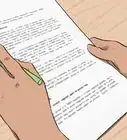This article was co-authored by Shannon O'Brien, MA, EdM and by wikiHow staff writer, Jennifer Mueller, JD. Shannon O'Brien is the Founder and Principal Advisor of Whole U. (a career and life strategy consultancy based in Boston, MA). Through advising, workshops and e-learning Whole U. empowers people to pursue their life's work and live a balanced, purposeful life. Shannon has been ranked as the #1 Career Coach and #1 Life Coach in Boston, MA by Yelp reviewers. She has been featured on Boston.com, Boldfacers, and the UR Business Network. She received a Master's of Technology, Innovation, & Education from Harvard University.
There are 9 references cited in this article, which can be found at the bottom of the page.
This article has been viewed 174,024 times.
Many employers now require a writing sample, or job application essay, to accompany all applications or résumés — even if writing is not a significant part of the position. The goal of the job application essay is to ensure that applicants have the right communication skills for the position offered. Sometimes, potential employers will provide a specific topic or series of questions for your essay to respond to. However, you may also be asked to provide an essay with no guidance whatsoever. Either way, approach the essay seriously so that it highlights the skills and assets you could bring to the company.[1]
Steps
Outlining Your Essay
-
1Read the job listing and essay description carefully. Your essay should respond directly to any instructions provided or questions asked by the employer. Part of the "test" with job application essays is to see how well you respond to questions and follow instructions.[2]
- As you read, write down keywords or phrases. Focus on traits or skills the employer is looking for in an ideal applicant. The hiring manager will likely scan for these words, so you'll want to highlight them in your essay.[3]
- If you don't know much about the company, do a little research on it before you start writing. You might look at their website or do a general internet search with the name of the company to see if any news articles or other reports come up. Go beyond the four corners of the job listing so that you understand who will likely be reading your essay.
- If there's anything in the job listing or essay requirements that you don't understand, contact the employer and ask about them. Employers are often impressed by applicants who clarify the employer's intent rather than making assumptions.
-
2State your theme or thesis statement upfront. If the potential employer has specified what your essay should be about, your essay as a whole should focus on that theme. If they've given you leeway to choose your own theme, choose something that is tailored to the position you're applying for.[4]
- For example, if you're applying for a position in sales, you might want to write an essay about your ability to tailor your pitch to specific clients and close the deal. If you have the ability to be more creative, you might tailor your essay to "sell" yourself directly to the employer.
Advertisement -
3Brainstorm 3 or 4 points that support your thesis statement. Once you have your thesis statement, think of specific skills or personality traits that make you the ideal applicant for the position. If the job listing includes required skills, make sure you include as many of those as possible.[5]
- For each of your points, think of a specific example you can relate briefly that illustrates the point. For example, if you've described yourself as a "team player," you might include an example of how you came in on your day off to complete some of the more monotonous tasks that no one else wanted to do so a project could be completed ahead of schedule.
- It's a good idea to have more than one example in your outline for each point, even if you only end up using one. That way, if you start writing something and it ends up not working as well as you thought it would, you'll have a back-up handy.
- Brainstorming can be difficult. If you find yourself churning over the same thoughts, stand up and take a break for a few minutes. Step outside or go for a walk to clear your head, then come back to it.
-
4Gather documents and information to fill out your points. Fill your examples and anecdotes with as many specific details as possible. This not only tells the employer that you have an eye for detail but also makes your examples more concrete and impressive. If you don't know the specific details off the top of your head, search your records or contact former employees or co-workers and get the information from them.[6]
- For example, if you want to describe how you increased sales in a specific quarter, you would want to state specifically how much you increased sales. Your former employer may have sales figures that you could ask them for. You might also have that information in your records.
- Wherever possible, use specific numbers and dates rather than making general statements. It's okay to estimate, but make sure your estimate is conservative. Saying you led your sales team to the highest sales in a quarter is impressive — but only if it's true.
Completing Your Rough Draft
-
1Start with an introductory paragraph that describes you and your essay. Begin your essay by introducing yourself and the name of the position you're applying for. Then go into the thesis or theme of your essay.[7]
- Think of this paragraph as telling the hiring manager what you're going to tell them in the essay. Outline the points you're going to elaborate on in the essay that back up your theme or thesis statement.
- Sometimes it's best to go back and write your introduction after you've written the body of your essay. That way, you can make sure the introduction provides an outline that matches the body.
-
2Organize your essay logically. Generally, it makes sense to lead with the point you think is the strongest. Imagine the hiring manager is only reading the first two paragraphs of your essay and use the second paragraph to describe the point you would want them to know if they knew nothing else about you. Then continue to the next strongest point.[8]
- If the employer listed specifically what should be included in your essay, follow their order, since that's what they'll be looking for when they read the essay.
- Write in the first person and make yourself the star of any anecdote you include as an example. Use action verbs to focus on what you did rather than focusing on what happened and how you reacted to it.[9]
-
3Create transitions between each paragraph of your essay. Even though your points may be relatively unrelated, come up with a way for your essay to move smoothly from one point to the next. You might focus on aspects of a particular job or details from a specific example you gave related to one point that allow you to segue to the next point.[10]
- For example, if you're writing about your skills as a team player, you might note that you discuss doing routine work that others found monotonous so they had time to work on other parts of a project. You could use that detail to move on to a section describing how you're detail-oriented.
-
4Use your closing to summarize your essay. If your introduction was about telling the reader what you were going to tell them in your essay, your closing is about summarizing what you've already told them. Bring those points back around to your theme or thesis statement and illustrate how you've proven that point.[11]
- For example, you might write "My business school education, skills as a team player, and focus on detail make me the best candidate to lead your sales team."
Finalizing Your Essay
-
1Proofread your essay for spelling, grammar, and typographical errors. Your writing style and creativity aren't nearly as important as producing an essay that's free of errors. Go through your essay carefully, focusing on one type of error at a time.[12]
- For example, you might start by looking solely at punctuation, then read through again focusing on spelling.
- If you find that you tend to repeat a particular error, go through your essay looking for that error specifically.
- If your grammar isn't particularly strong or you're writing in a language other than your native language, have someone else read over your essay as well.
-
2Read your essay out loud. Reading your essay out loud forces you to focus on each word individually, making it easier to notice errors. You can also identify parts that are worded awkwardly or are difficult to read.[13]
- If you find that you stumble over a sentence while reading aloud, that's a sign that your writing could be clearer. Work with your text until you have something that you can read aloud with ease.
-
3Edit your essay for clarity and to fit the specified length. If the job listing provided a maximum length for your essay, make sure your essay is safely below that limit. Avoid playing tricks with formatting to make your essay fit a certain page requirement — employers will be able to tell.[14]
- If the prospective employer did not specify a length, try to keep your essay under 2 double-spaced pages. Remember that hiring managers are busy and don't have a lot of time to read a long, rambling essay.
- Eliminate all unnecessary words or sentences that aren't relevant to the subject of your essay. The majority of your sentences should be short, declarative sentences with action verbs.
- Apps such as Hemingway (http://www.hemingwayapp.com/) or Grammarly (https://app.grammarly.com/) can help you identify portions of your essay that are more difficult to read. Both of these apps have a free version that you can use to edit your text.
-
4Work backward through your essay to proofread a second time. When you read through your work from the beginning, your familiarity with the text can cause you to miss errors. By starting with the last sentence and working your way backward through the text, you may pick up errors that you otherwise would have missed.[15]
- Working backward is particularly helpful for noticing spelling mistakes, especially hard-to-catch homophone errors, because you're seeing the word out of context.
-
5Print your essay and read through it a final time. You may notice errors when you look at a print version of your essay that you would've missed if you were reading it on your computer screen. Take your time and read slowly to make sure your essay is perfect before you submit it to the employer.[16]
- It may also help to print your essay in a different font or font size than what you used to type it. This breaks your brain's familiarity with the text, which can make typos and other errors more noticeable. Just remember to change the font back after you print it.
Job Application Essay
Expert Q&A
-
QuestionWhat do I include in an application essay?
 Shannon O'Brien, MA, EdMShannon O'Brien is the Founder and Principal Advisor of Whole U. (a career and life strategy consultancy based in Boston, MA). Through advising, workshops and e-learning Whole U. empowers people to pursue their life's work and live a balanced, purposeful life. Shannon has been ranked as the #1 Career Coach and #1 Life Coach in Boston, MA by Yelp reviewers. She has been featured on Boston.com, Boldfacers, and the UR Business Network. She received a Master's of Technology, Innovation, & Education from Harvard University.
Shannon O'Brien, MA, EdMShannon O'Brien is the Founder and Principal Advisor of Whole U. (a career and life strategy consultancy based in Boston, MA). Through advising, workshops and e-learning Whole U. empowers people to pursue their life's work and live a balanced, purposeful life. Shannon has been ranked as the #1 Career Coach and #1 Life Coach in Boston, MA by Yelp reviewers. She has been featured on Boston.com, Boldfacers, and the UR Business Network. She received a Master's of Technology, Innovation, & Education from Harvard University.
Life & Career Coach Look for keywords or specific language the company uses on the job post or on their website. Then, incorporate some of those words into your essay to show that you've done your research.
Look for keywords or specific language the company uses on the job post or on their website. Then, incorporate some of those words into your essay to show that you've done your research. -
QuestionWhat is the appropriate length of a job application essay?
 Community Answer250 - 500 words should be OK.
Community Answer250 - 500 words should be OK. -
QuestionHow do you start a job application essay?
 Drew Hawkins1Community AnswerIdeally, you always want to start with a solid intro that describes who you are and what your essay will be about. Introduce yourself and name the specific position you're applying for. Think of it like you're trying to sell yourself as the ideal candidate for the job. End your introductory paragraph with a thesis that makes the claim that they should choose you for the job. Then, you can go into the rest of your essay making arguments that support your thesis. In fact, it may be a good idea to write your entire essay, making all of the points you want to make about why you're the right choice. Then, you can go back and write your introductory paragraph in a way that briefly touches on the rest of your essay. That way it feels much more like a cohesive unit and can make for a more compelling argument.
Drew Hawkins1Community AnswerIdeally, you always want to start with a solid intro that describes who you are and what your essay will be about. Introduce yourself and name the specific position you're applying for. Think of it like you're trying to sell yourself as the ideal candidate for the job. End your introductory paragraph with a thesis that makes the claim that they should choose you for the job. Then, you can go into the rest of your essay making arguments that support your thesis. In fact, it may be a good idea to write your entire essay, making all of the points you want to make about why you're the right choice. Then, you can go back and write your introductory paragraph in a way that briefly touches on the rest of your essay. That way it feels much more like a cohesive unit and can make for a more compelling argument.
Warnings
- Unless you're applying for a position in a political or religious organization, avoid including anything in your essay that identifies your political or religious preferences or beliefs.[18]⧼thumbs_response⧽
- Avoid using humor, especially sarcasm or ironic humor, as it can be misconstrued in text. Additionally, humor may lead the hiring manager to believe that you aren't serious about the position.[19]⧼thumbs_response⧽
References
- ↑ https://www.monster.com/career-advice/article/writing-sample-job-application
- ↑ https://www.insidehighered.com/advice/2012/04/30/essay-how-write-good-applications-jobs-or-grants
- ↑ Shannon O'Brien, MA, EdM. Life & Career Coach. Expert Interview. 25 May 2021.
- ↑ https://www.insidehighered.com/advice/2012/04/30/essay-how-write-good-applications-jobs-or-grants
- ↑ https://careersblog.warwick.ac.uk/2016/03/14/looking-at-a-person-spec-how-to-make-the-employer-interview-you/
- ↑ https://careersblog.warwick.ac.uk/2016/03/14/looking-at-a-person-spec-how-to-make-the-employer-interview-you/
- ↑ https://www.insidehighered.com/advice/2012/04/30/essay-how-write-good-applications-jobs-or-grants
- ↑ https://www.govloop.com/community/blog/government-job-application-essays-made-easy/
- ↑ https://writingcenter.unc.edu/tips-and-tools/application-essays/
- ↑ https://www.govloop.com/community/blog/government-job-application-essays-made-easy/
- ↑ https://writingcenter.unc.edu/tips-and-tools/application-essays/
- ↑ https://writingcenter.unc.edu/tips-and-tools/editing-and-proofreading/
- ↑ https://www.quickanddirtytips.com/education/grammar/proofreading-tips
- ↑ https://www.govloop.com/community/blog/government-job-application-essays-made-easy/
- ↑ https://www.quickanddirtytips.com/education/grammar/proofreading-tips
- ↑ https://www.quickanddirtytips.com/education/grammar/proofreading-tips
- ↑ https://www.govloop.com/community/blog/government-job-application-essays-made-easy/
- ↑ https://www.psychologytoday.com/us/blog/career-transitions/200906/the-dreaded-writing-sample
- ↑ https://www.psychologytoday.com/us/blog/career-transitions/200906/the-dreaded-writing-sample
About This Article
Job application essays can seem scary, but they’re really just an opportunity for you to highlight your skills and explain why you’re suitable for the role. Read the job listing to find out what traits and skills the company is looking for, like time management, working under pressure, and leadership. If you don’t know much about the company, read through its website and do an online search to find articles about its work. In your introduction, you’ll want to to describe yourself and introduce the main points you’ll be making. Then, write a paragraph for each trait or skill. Use real life examples from previous jobs, your recent studies, or extracurricular activities to support your points. For example, you could highlight your leadership skills by talking about a time you led a group project that exceeded your targets. For more tips, including how to write a compelling conclusion for your job application essay, read on!



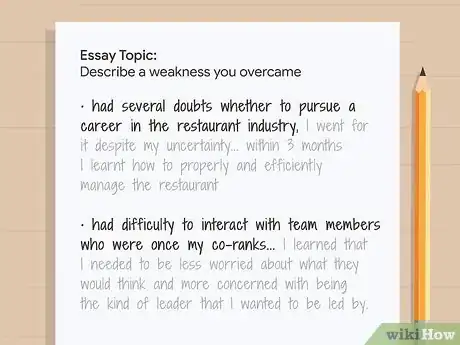
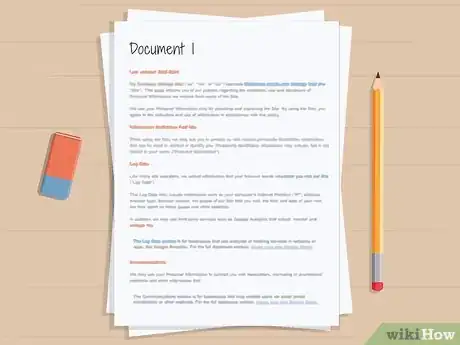

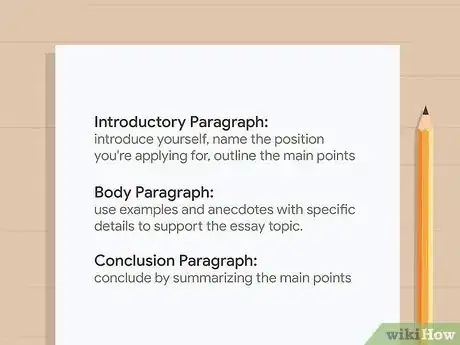
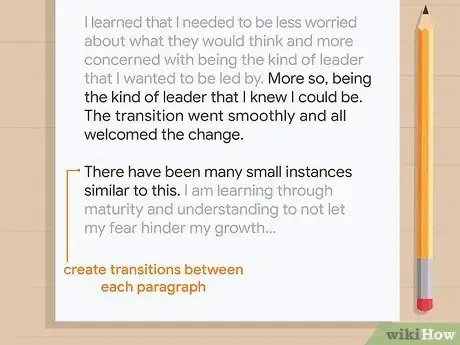
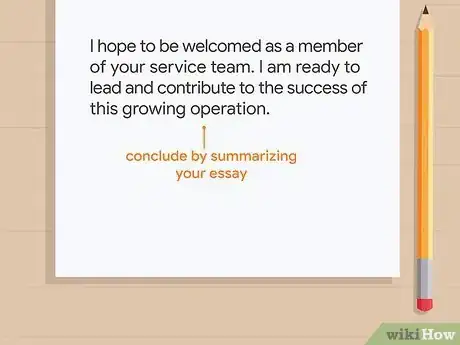
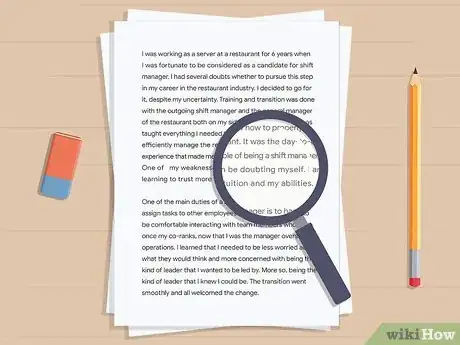

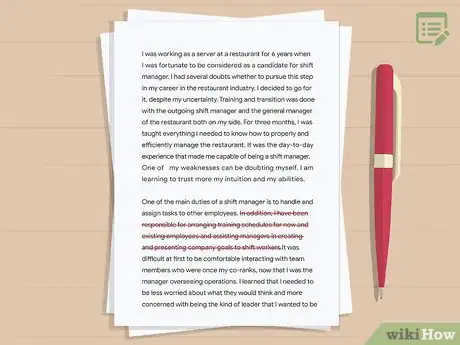
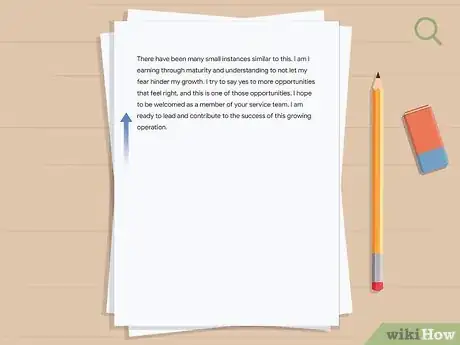
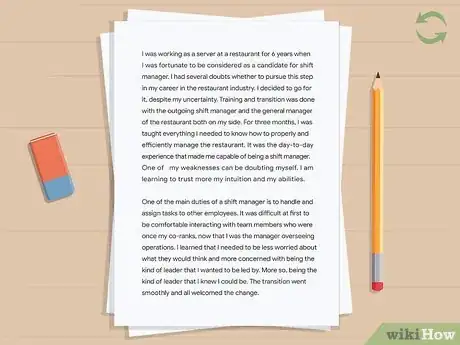
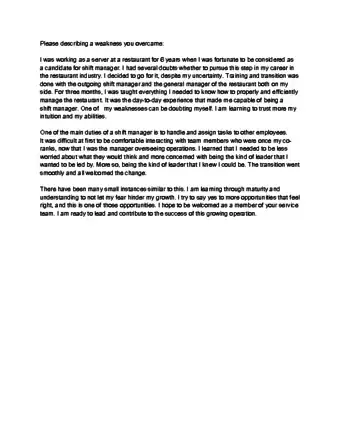
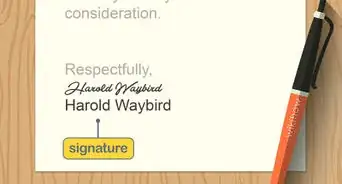
-Step-17-Version-3.webp)




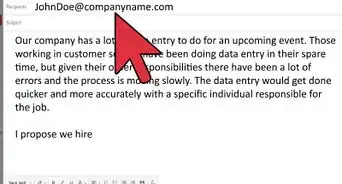
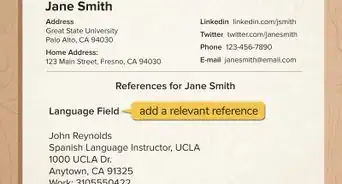
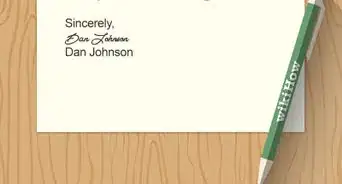


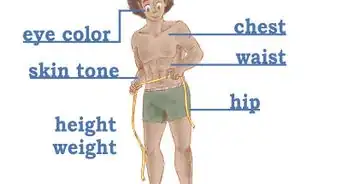
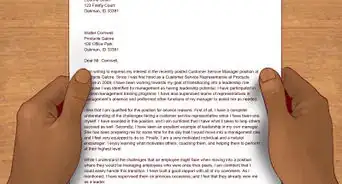
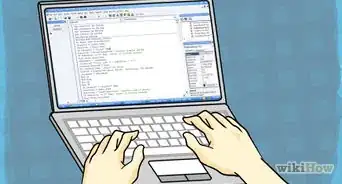






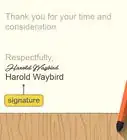
-Step-17-Version-3.webp)

